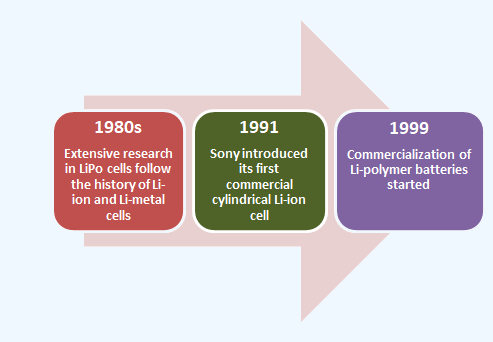Lithium-polymer Battery
Inventor/Assignee: Takaki Mori, Takeshi Koike, Hyung-bok Lee | Samsung SDI Co Ltd
Description:
Introduction: Lithium polymer cells have evolved from lithium-ion and lithium-metal batteries. A lithium-polymer (LiPo) battery is a type of rechargeable battery that uses a soft polymer casing so that the lithium-ion battery inside it rests in a soft external “pouch.” It may also refer to a lithium-ion battery that uses a gelled polymer as an electrolyte. However, the term commonly refers to a type of lithium-ion battery in a pouch format. The more accurate name for this type of battery is lithium-ion polymer battery. Lithium-polymer batteries are lighter and more flexible than other kinds of lithium-ion batteries because of their soft shells, allowing them to be used in mobile and other electronic devices, as well as in remote control vehicles.
Maturity Timeline:

Advantages:
Some significant advantages of LiPo batteries are:
- Safe to use: It has a simple PCM design and is comparatively safer..
- Great power supply: It adds a stable and autonomous power supply to your devices.
- Environment friendly: LiPo batteries are eco-friendly and have many advantages compared to other NiMH and NiCd batteries.
- Multiple functionalities: Use LiPo batteries in emergency lighting, wireless, cordless telephones, digital cameras, and mobile devices.
- More robust & flexible: Li-polymer batteries are more flexible, lightweight, and robust.
- Less electrolytes leakage: The leakage of electrolytes is very rare in LiPo batteries, and they have a low profile.
- No compromise on quality: LiPo batteries' lifespan and energy density are not the same as Li-ion and other batteries.
- More stable discharge characteristics: It uses colloidal electrolytes, which have a high and stable discharge platform and characteristics.
- Powerful bank house & high voltage: Li-polymer batteries have a lot of beneficial features, such as fire-retardant shells, short circuits, and powerful bank houses. The voltage of the LiPo battery is 3.7 V which is equivalent to three NiDM batteries.
- Use in various industries: AC cars, boats, and notebook computers also use LiPo batteries for a better power supply.
- Safe transportation: LiPo battery uses polymer electrolytes which form with high conductivity gel. It ensures safe transportation.
- Provide massive power: It offers massive power and operates in various electric vehicles, UPS systems, and mobile devices.
- Less pollution: Lithium polymer batteries do not use any harmful materials such as mercury, lead and cadmium. So it does not create pollution in the environment.
- No memory effect: Memory effect is the process in which the capacity of NiCd batteries decreases during the cycle of discharge and charge. LiPo batteries are free from this memory effect.
- Low internal resistance: Lithium polymer batteries have less internal resistance as compared to other batteries. This resistance may help extend standby time for various applications.
Limitations:
- Although LiPo battery considers one of the safest forms of RC battery, it should be store, charge, and discharge with proper care.
- LiPo battery doesn’t expire, but excessive and improper use and handling can decrease its performance.
- LiPo battery can support less recharge life, at least 300-400 cycles.
- When LiPo battery punctures, it may be lead to a fire.
- It is more expensive than other batteries.
- It has no standard shape and high power as compared to other batteries.
Performance: Lithium-polymer battery is a combination of a cylindrical and rectangular-shaped structure. The internal structure is bounded spirally, which helps create a partition between the anode and the cathode portions of the battery by putting a concise and highly porous polyethylene layer between the two. Lithium Polymer batteries work on the principle of using liquid electrolyte solution, so a portion of the battery is filled with organic liquid electrolyte solution. Also, to protect the battery from unprecedented incidents such as short circuit or explosions, safety valves, and PTC components are installed. Followed by these, cells are installed either in a series or parallel to one another. The number of cells varies depending on the total voltage requirement of the battery. The voltage of one cell is 3.6V and the total voltage of the battery is the sum of the voltage of the cells installed.
A typical cell has four main components: positive electrode, negative electrode, separator and electrolyte. The separator itself may be a polymer, such as a microporous film of polyethylene (PE) or polypropylene (PP); thus, even when the cell has a liquid electrolyte, it will still contain a "polymer" component. In addition to this, the positive electrode can be further divided into three parts: the lithium-transition-metal-oxide (such as LiCoO2 or LiMn2O4), a conductive additive, and a polymer binder of poly (vinylidene fluoride) (PVdF). The negative electrode material may have the same three parts, only with carbon replacing the lithium-metal-oxide
Lithium-polymer technology uses a positive and negative electrode, but with a dry solid, porous chemical, or gel-like electrolyte, rather than a liquid. As a result, polymer batteries can offer a lower profile, flexible, and more robust designs. As they, they also have a lower chance of leaking electrolytes resulting in thermal runaway. In a nutshell, they’re a fair bit safer. However, they aren’t completely immune from issues arising from being punctured, stressed, or overheated.
Like other lithium-ion cells, LiPos work on the principle of intercalation and de-intercalation of lithium ions from a positive electrode material and a negative electrode material, with the liquid electrolyte providing a conductive medium. To prevent the electrodes from touching each other directly, a microporous separator is in between which allows only the ions and not the electrode particles to migrate from one side to the other.
Use Cases: Industrial use; Drones, radio-controlled equipment and aircraft; Personal electronics; Automotive equipments including electric vehicles; Power supply systems; Medical devices
Patent: US6884547B2
Theme: Battery Technology | Subtheme: Lithium-polymer (Li-Po)
Source:
Lithium Polymer Battery (LiPo Battery)
15 Advantages of Lithium-Polymer Battery
Introduction to Lithium Polymer Battery Technology



